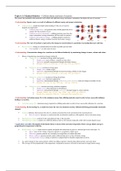Summary
Summary IB Chemistry Topic 6,7: Chemical Kinetics, Equilibrium
- Course
- Institution
- Book
Detailed objective-by-objective summary notes for Topic 6,7: Chemical Kinetics and Equilibrium for IB Chemistry SL/HL. Contains information on everything you need to know according to each understanding, application or skill. Written by a IB HL Chemistry student who graduated with a 45/45.
[Show more]



